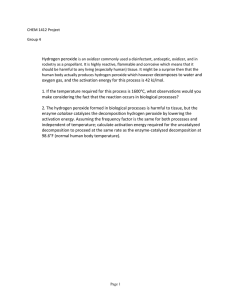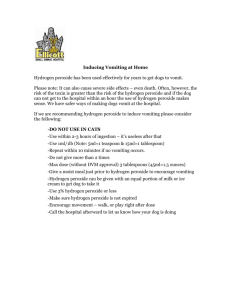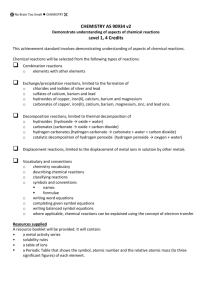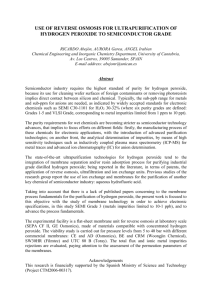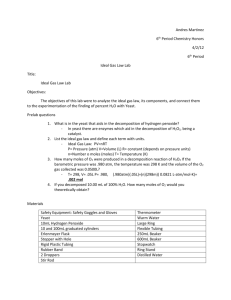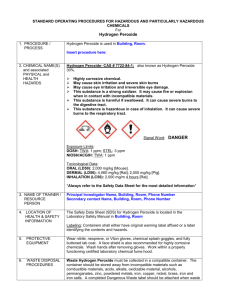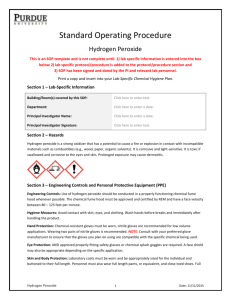The Decomposition of Hydrogen Peroxide
advertisement
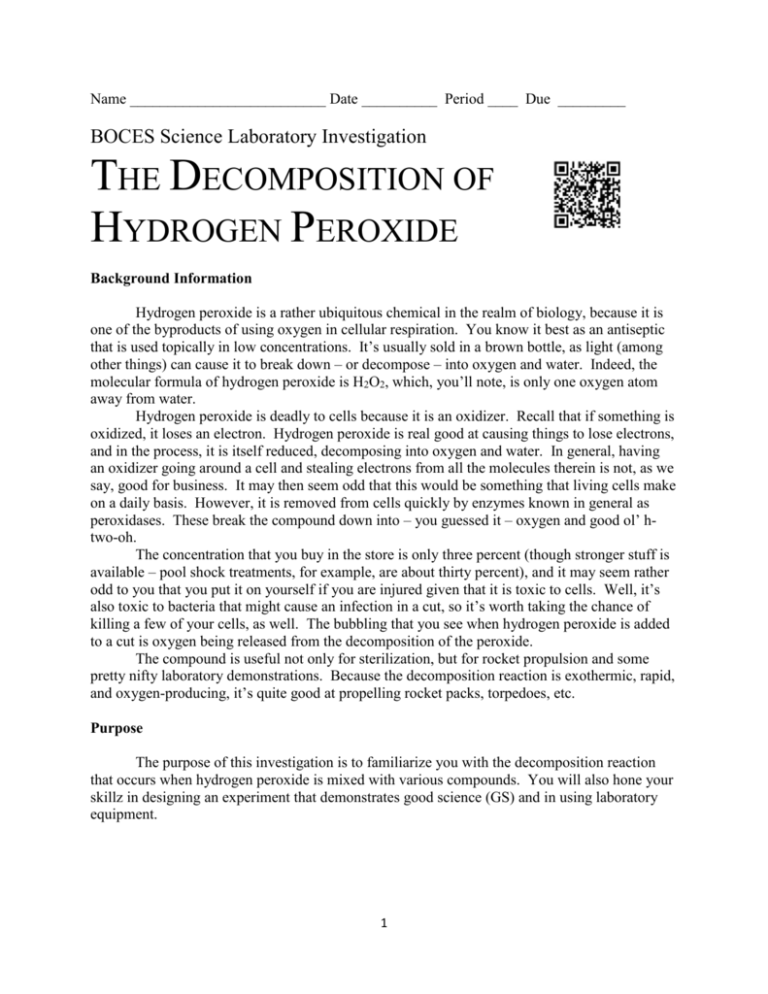
Name __________________________ Date __________ Period ____ Due _________ BOCES Science Laboratory Investigation THE DECOMPOSITION OF HYDROGEN PEROXIDE Background Information Hydrogen peroxide is a rather ubiquitous chemical in the realm of biology, because it is one of the byproducts of using oxygen in cellular respiration. You know it best as an antiseptic that is used topically in low concentrations. It’s usually sold in a brown bottle, as light (among other things) can cause it to break down – or decompose – into oxygen and water. Indeed, the molecular formula of hydrogen peroxide is H2O2, which, you’ll note, is only one oxygen atom away from water. Hydrogen peroxide is deadly to cells because it is an oxidizer. Recall that if something is oxidized, it loses an electron. Hydrogen peroxide is real good at causing things to lose electrons, and in the process, it is itself reduced, decomposing into oxygen and water. In general, having an oxidizer going around a cell and stealing electrons from all the molecules therein is not, as we say, good for business. It may then seem odd that this would be something that living cells make on a daily basis. However, it is removed from cells quickly by enzymes known in general as peroxidases. These break the compound down into – you guessed it – oxygen and good ol’ htwo-oh. The concentration that you buy in the store is only three percent (though stronger stuff is available – pool shock treatments, for example, are about thirty percent), and it may seem rather odd to you that you put it on yourself if you are injured given that it is toxic to cells. Well, it’s also toxic to bacteria that might cause an infection in a cut, so it’s worth taking the chance of killing a few of your cells, as well. The bubbling that you see when hydrogen peroxide is added to a cut is oxygen being released from the decomposition of the peroxide. The compound is useful not only for sterilization, but for rocket propulsion and some pretty nifty laboratory demonstrations. Because the decomposition reaction is exothermic, rapid, and oxygen-producing, it’s quite good at propelling rocket packs, torpedoes, etc. Purpose The purpose of this investigation is to familiarize you with the decomposition reaction that occurs when hydrogen peroxide is mixed with various compounds. You will also hone your skillz in designing an experiment that demonstrates good science (GS) and in using laboratory equipment. 1 Materials Test tubes Filter paper Potatoes Yeast Hotplate Ice Sodium hydroxide Other reagents as needed Test tube rack Fresh liver PENCIL Fresh horseradish Temperature probes Hydrochloric acid Assorted glassware Procedure Before you begin, you need to make a hypothesis. Remember, hypotheses are usually best phrased in the form “I think that if…..then….” Create a hypothesis about how quickly hydrogen peroxide will decompose when exposed one of several compounds or conditions available to you. See table 1 for some important factors to consider, though there are others! QUESTION 1: What is your hypothesis? QUESTION 2: How will you test your hypothesis? You may write, draw, or both. Teacher Initials _________ 2 Phenomenon Relation to Experiment Oxygen is a gas and displaces water, so it can be collected and measured. Oxygen is flammable, so its presence can be detected with fire. The bubbles will float and may float other small objects. They are also discreet and can be counted. The more surface area of a compound that is available to react, the faster a reaction will proceed. Heat, cold, pH, pressure and other factors can change the rate at which a catalyst functions. Oxygen is produced during the decomposition of hydrogen peroxide Oxygen bubbles are produced by decomposition in a liquid Breaking something into smaller pieces increases its surface area Catalysts, both organic and inorganic, work only under very specific conditions Table 1. A list of potentially useful phenomena 1. Have your experimental design approved by your teacher. Remember that it must be able to be completed within a double lab period. 2. Construct a data table to collect your results. Remember, you will only be measuring one variable! QUESTION 3: Design your data table in the space below. Use a RULER and make it NEAT. Alternately, design your table using a computer, and attach it at the end of the lab. 3. Set up your experiment and collect your data. Remember, you’ll have only two class periods to collect your data. 4. Create a lab report based on the format outlined on the “So You Want to Write a Lab Report” sheet. Your report must be typed and neat. It should not contain a copy of your data table; instead, turn your data into an easy-to-understand graph. For guidance on graphing, see the “So You Want to Make a Graph” sheet. 3


